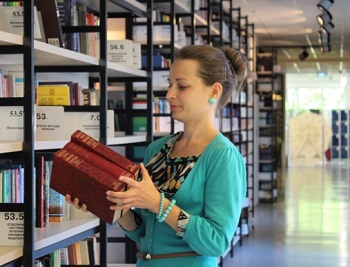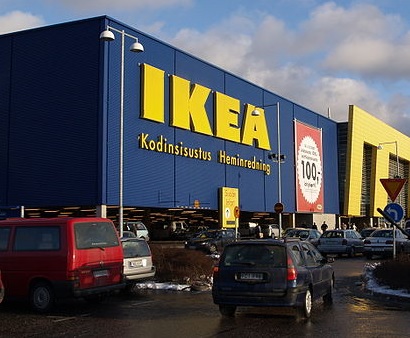A company in India is printing quick response codes on front pages following each chapter for PDF access.
The Maharashtra State Bureau of Textbook Production and Curriculum Research (Balbharti) in India has announced the launch of new QR code textbooks that have been designed to make it easier for students to obtain digital copies and to lighten the load they need to carry in their schoolbags.
The books are being produced for the Class VI syllabus which was recently changed and re-printed.
The new QR code textbooks have barcodes printed on each of the front pages following the chapters which directs the smartphone or tablet user to the official Balbharti website, where all class textbooks can be obtained in PDF format. The hope is that the quick response codes will also be helpful in accessing a smartphone app that is currently in its planning stages.
By using QR code textbooks, students would be required to carry far less in their schoolbags each day.
 The Balbharti website is also undergoing a makeover at the same time that the mobile app is being developed. The hope is that by making the site easier to use, students will be more likely to opt for the digital versions of the textbooks and will not have to carry as much in their bags. The site’s updates will include an e-learning link of both the Marathi and English language magazines such as Kishor. Kishor is a teen focused magazine that is published on a monthly basis by Balbharti. The magazine is celebrating its fortieth anniversary.
The Balbharti website is also undergoing a makeover at the same time that the mobile app is being developed. The hope is that by making the site easier to use, students will be more likely to opt for the digital versions of the textbooks and will not have to carry as much in their bags. The site’s updates will include an e-learning link of both the Marathi and English language magazines such as Kishor. Kishor is a teen focused magazine that is published on a monthly basis by Balbharti. The magazine is celebrating its fortieth anniversary.
The Balbharti controller, Vivek Gosavi, has explained that the size of the textbook has grown to A4 page size to make it possible to print it in a larger font that is more legible and appealing to both students and teachers. However, because of the larger page size, it also means that the books have grown, making them bigger and heavier inside a student’s bag.
Gosavi explained about the QR code textbooks that they are currently being “used as pilot project this year. At least students in urban Maharashtra would get the benefit of this feature. We will observe the response of this feature and will decide on the scope of its introduction in other books next year.”
The world’s largest furniture retailer is trying out a new QR code pilot program.
IKEA is well known for being an innovative and forward-thinking company and its new quick response codes (QR codes) mobile checkout system, which it is currently piloting in France, is no exception. If all goes according to plan, the new system will make it much easier and faster for customers to checkout at physical stores.
Customers can use their smartphone cameras to help improve their shopping experience in-store.
The new system merges online shopping with brick-and-mortar shopping by requiring customers to use their smartphones while shopping in the store and at checkout.
 How it works is quite simple. Using an IKEA app, customers scan the items they intend to purchase from the store with their mobile phone and place the items in their cart as they shop. Once they reach the checkout point, the app combines all the items they’ve scanned to obtain the total purchase. From there it generates a QR code. This unique quick response code is scanned at checkout, so the customer can pay for their purchase with quick ease.
How it works is quite simple. Using an IKEA app, customers scan the items they intend to purchase from the store with their mobile phone and place the items in their cart as they shop. Once they reach the checkout point, the app combines all the items they’ve scanned to obtain the total purchase. From there it generates a QR code. This unique quick response code is scanned at checkout, so the customer can pay for their purchase with quick ease.
With only one scan required, quick response codes make the checkout process at IKEA a breeze.
Such a system is highly convenient for a store like IKEA where it is not uncommon for customers to purchase several large items that can be awkward to scan individually at checkout. This is especially the case if the barcode of a large and heavy item that needs to be scanned has been placed upside down in the cart. The new mobile checkout system eliminates this hassle.
IKEA’s global head of mobile solutions, Victor Bayata, said that what IKEA is looking at is “giving the customer the power to decide what to do and where to take the next step.” Bayata added that “What we need to do, and this is again the formula that everyone tries and tests, is that we need to understand our customers’ needs and wants.”
He explained that understanding how to combine the online experience with how people act in the store is how the company will provide their customers with “services that make sense.”
If the pilot project proves successful in France, the quick response codes checkout feature at IKEA is likely to be tried at other store locations and could make shopping in physical stores more attractive to customers, improving their overall in-store shopping experience.
 The Balbharti website is also undergoing a makeover at the same time that the mobile app is being developed. The hope is that by making the site easier to use, students will be more likely to opt for the digital versions of the textbooks and will not have to carry as much in their bags. The site’s updates will include an e-learning link of both the Marathi and English language magazines such as Kishor. Kishor is a teen focused magazine that is published on a monthly basis by Balbharti. The magazine is celebrating its fortieth anniversary.
The Balbharti website is also undergoing a makeover at the same time that the mobile app is being developed. The hope is that by making the site easier to use, students will be more likely to opt for the digital versions of the textbooks and will not have to carry as much in their bags. The site’s updates will include an e-learning link of both the Marathi and English language magazines such as Kishor. Kishor is a teen focused magazine that is published on a monthly basis by Balbharti. The magazine is celebrating its fortieth anniversary.
 How it works is quite simple. Using an IKEA app, customers scan the items they intend to purchase from the store with their mobile phone and place the items in their cart as they shop. Once they reach the checkout point, the app combines all the items they’ve scanned to obtain the total purchase. From there it generates a QR code. This
How it works is quite simple. Using an IKEA app, customers scan the items they intend to purchase from the store with their mobile phone and place the items in their cart as they shop. Once they reach the checkout point, the app combines all the items they’ve scanned to obtain the total purchase. From there it generates a QR code. This 